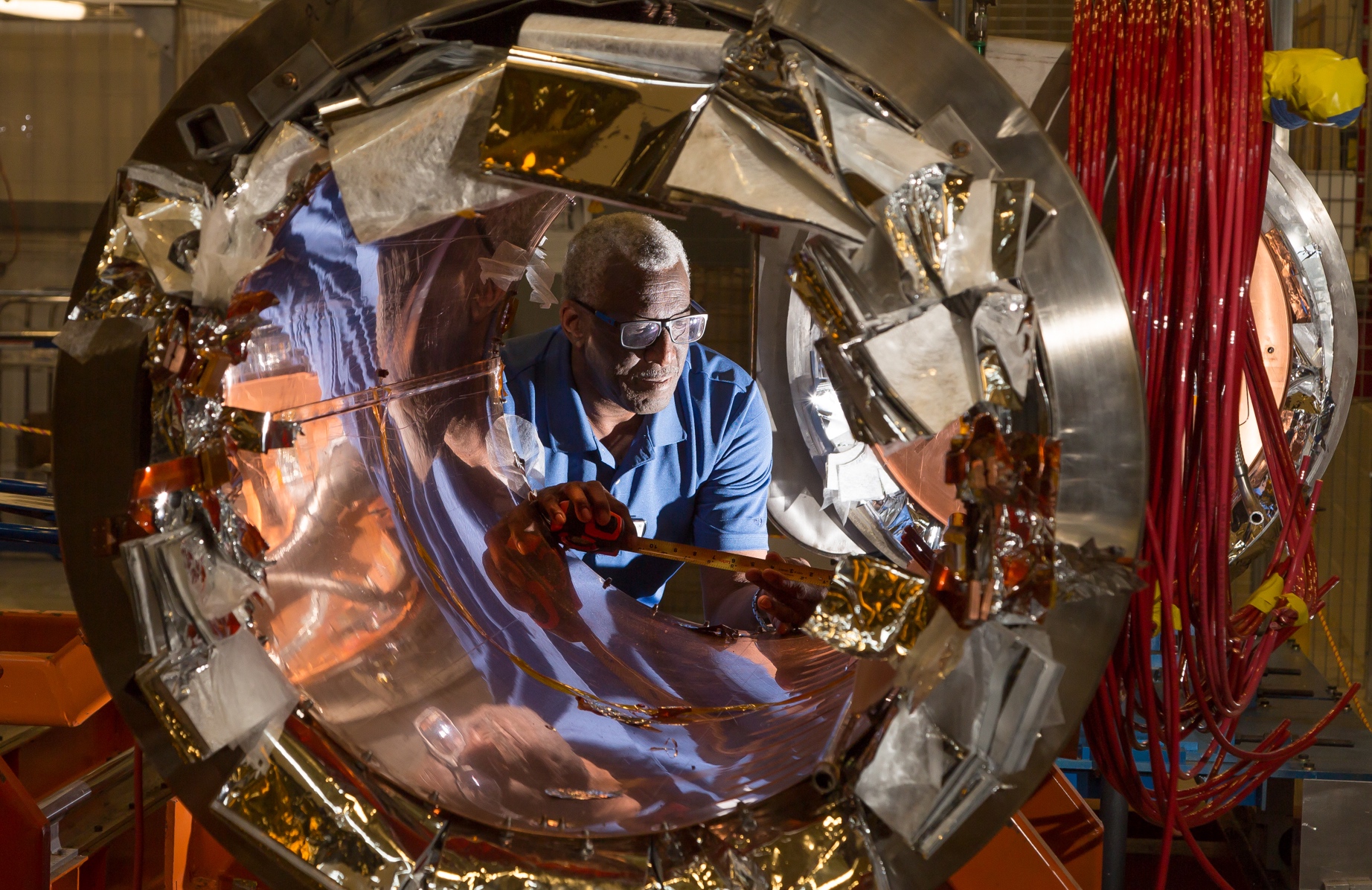A JLab staff member makes measurements of a section of cryomodule that has been disassembled for the C75 cryomodule program.
The cost-effective C75 cryomodule program refurbishes
particle accelerator parts by mixing old and new technology
Even particle accelerators need a refresh every once in a while. The Continuous Electron Beam Accelerator Facility (CEBAF) at the U.S. Department of Energy's Thomas Jefferson National Accelerator Facility is no exception.
CEBAF produces a powerful electron beam by shuttling electrons around its racetrack shape. Physicists probe different targets with CEBAF’s beam to learn more about the atomic nucleus.
The main structural unit of CEBAF, like many other particle accelerators, is called a cryomodule. In total, CEBAF is comprised of about 50 cryomodules lined up end to end in two linear accelerators of the same length (North and South Linacs). However, not every cryomodule is the same: they differ in how well they accelerate the electrons running through them, and each cryomodule’s performance also declines due to wear and tear from operations.
Now, Jefferson Lab scientists and engineers are enhancing the performance of its poorest performing cryomodules, an effort known as the C75 cryomodule program.
“The purpose of the program is to increase the energy output from refurbished cryomodules from CEBAF,” said Gianluigi “Gigi” Ciovati, an accelerator scientist who holds a joint appointment at Jefferson Lab and Old Dominion University.
Cryomodules are classified by their performance, or the total amount of acceleration they give to electrons. All of the cryomodules originally installed in CEBAF were C20 cryomodules, named such because they provide electrons in the accelerator’s beam with 20 MeV energy gain.
Between 2006 and 2017, thirteen of these original C20 cryomodules were refurbished, transforming them into C50 cryomodules, capable of providing electrons with 50 MeV energy gain. Additionally, when Jefferson Lab upgraded CEBAF’s electron beam energy to 12 GeV in 2017, CEBAF received ten new C100 cryomodules built from scratch at Jefferson Lab.
Despite these improvements and additions, some original, un-refurbished C20 cryomodules remain. To ensure that CEBAF maintains its total energy output over time, the poorest-performing cryomodules must be refurbished. Through the C75 cryomodule program, Jefferson Lab scientists, engineers and technicians plan to revamp 10 of the C20 cryomodules.
“The cryomodules that are performing the worst, they’re the ones that are going to be pulled out,” said Ciovati. “And when they’re reassembled, the goal is for them to provide a 75 MeV energy gain.”
The previous refurbishment method transformed C20 cryomodules into C50 cryomodules, but Jefferson Lab’s scientists realized this wasn’t keeping up with CEBAF’s energy needs. The C75 cryomodule program, which was originally conceived by Arne Freyberger, Ganapati Myneni and Robert Rimmer, will employ a new, more cost-effective refurbishment method.
“We needed to step up the energy that can be gained per refurbishment,” Ciovati explained.
While the previous method exclusively reused original parts from the cryomodule, the new method will both recycle parts from the original cryomodule and add new parts featuring new technology.
Inside every cryomodule sit eight special tubes called cavities. The beam travels through these cavities, which use superconducting radiofrequency technology to accelerate the electrons to the energy required for physics experiments. Structures called end groups bookend the accelerating cells on either side of a cavity.
The C75 cryomodule program will reuse these end structures and build entirely new accelerating cells.
“This method is basically the most cost-effective way to try to get more energy out of the old cryomodules,” Ciovati said. “It’s very expensive to rebuild new end groups.”
The freshly built cavities will be a different shape and different material than their predecessors.
Cavities in the old C20 cryomodules are made of standard fine grain niobium, but the new C75 cavities will be made of large grain niobium, which is three times cheaper than fine grain niobium.
“The new material and new shape of the new cavities will allow them to perform to a higher accelerating gradient,” Ciovati said. The C75 cryomodules will also feature an additional layer of magnetic shielding around their cavities to improve efficiency, another technological improvement from their predecessors.
The program is currently preparing cavities for its first C75 cryomodule. Jefferson Lab buys niobium for the cavities, and then sends the material to a company that builds them (Research Instruments GmbH, Germany). As a technical representative for the C75 cryomodule program, Ciovati acts as the liaison between Jefferson Lab and the cavity manufacturer in Germany.
Ciovati says current plans call for installation of the first C75 cryomodule during a shutdown period later this year.
Over the next five years, the program plans to build and install eight more C75 cryomodules.
By Chris Patrick
Contact: Kandice Carter, Jefferson Lab Communications Office, 757-269-7263, kcarter@jlab.org


